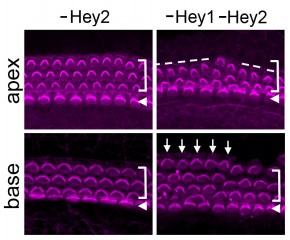Proteins Hey1 and Hey2 Ensure that Inner Ear 'Hair Cells' Are Made at the Right Time and in the Right Place

Angelika Doetzlhofer The hair cells of mice missing just Hey2 are neatly lined up in four rows (left) while those missing Hey1 and Hey2 are disorganized (right). The cells' hairlike protrusions (pink) can be misoriented, too.
“The proteins Hey1 and Hey2 act as brakes to prevent hair cell generation until the time is right,” says Angelika Doetzlhofer, Ph.D., an assistant professor of neuroscience. “Without them, the hair cells end up disorganized and dysfunctional.”
The cochlea is a coiled, fluid-filled structure bordered by a flexible membrane that vibrates when sound waves hit it. This vibration is passed through the fluid in the cochlea and sensed by specialized hair cells that line the tissue in four precise rows. Their name comes from the cells’ hairlike protrusions that detect movement of the cochlear fluid and create electrical signals that relay the sound to the brain.
During development, “parent cells” within the cochlea gradually differentiate into hair cells in a precise sequence, starting with the cells at the base of the cochlea and progressing toward its tip. The signaling protein Sonic Hedgehog was known to be released by nearby nerve cells in a time- and space-dependent pattern that matches that of hair cell differentiation. But the mechanism of Sonic Hedgehog’s action was unclear.
Doetzlhofer and postdoctoral fellow Ana Benito Gonzalez bred mice whose inner ear cells were missing Hey1 and Hey2, two genes known to be active in the parent cells but turned off in hair cells. They found that, without those genes, the cells were generated too early and were abnormally patterned: Rows of hair cells were either too many or too few, and their hairlike protrusions were often deformed and pointing in the wrong direction.
“While these mice didn’t live long enough for us to test their hearing, we know from other studies that mice with disorganized hair cell patterns have serious hearing problems,” says Doetzlhofer.
Further experiments demonstrated the role of Sonic Hedgehog in regulating the two key genes.
“Hey1 and Hey2 stop the parent cells from turning into hair cells until the time is right,” explains Doetzlhofer. “Sonic Hedgehog applies those ‘brakes,’ then slowly releases pressure on them as the cochlea develops. If the brakes stop working, the hair cells are generated too early and end up misaligned.”
She adds that Sonic Hedgehog, Hey1 and Hey2 are found in many other parent cell types throughout the developing nervous system and may play similar roles in timing the generation of other cell types.
This work was supported by grants from the Whitehall Foundation (2010-05-81) and the National Institute on Deafness and other Communication Disorders (F32DC013477, DC005211).
On the Web:
View the article at The Journal of Neuroscience (after the embargo lifts). http://dx.doi.org/10.1523/JNEUROSCI.1494-14.2014
Learn more about Angelika Doetzlhofer.
www.hopkinsmedicine.org/profiles/results/directory/profile/6477655/angelika-doetzlhofer
Media Contact
All latest news from the category: Life Sciences and Chemistry
Articles and reports from the Life Sciences and chemistry area deal with applied and basic research into modern biology, chemistry and human medicine.
Valuable information can be found on a range of life sciences fields including bacteriology, biochemistry, bionics, bioinformatics, biophysics, biotechnology, genetics, geobotany, human biology, marine biology, microbiology, molecular biology, cellular biology, zoology, bioinorganic chemistry, microchemistry and environmental chemistry.
Newest articles

A universal framework for spatial biology
SpatialData is a freely accessible tool to unify and integrate data from different omics technologies accounting for spatial information, which can provide holistic insights into health and disease. Biological processes…

How complex biological processes arise
A $20 million grant from the U.S. National Science Foundation (NSF) will support the establishment and operation of the National Synthesis Center for Emergence in the Molecular and Cellular Sciences (NCEMS) at…

Airborne single-photon lidar system achieves high-resolution 3D imaging
Compact, low-power system opens doors for photon-efficient drone and satellite-based environmental monitoring and mapping. Researchers have developed a compact and lightweight single-photon airborne lidar system that can acquire high-resolution 3D…





















